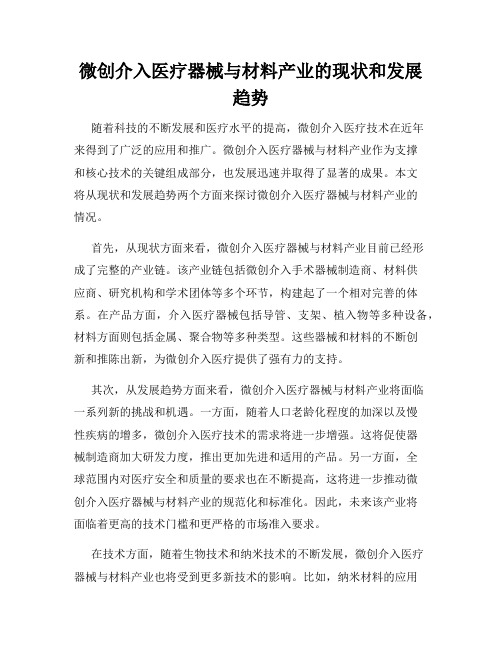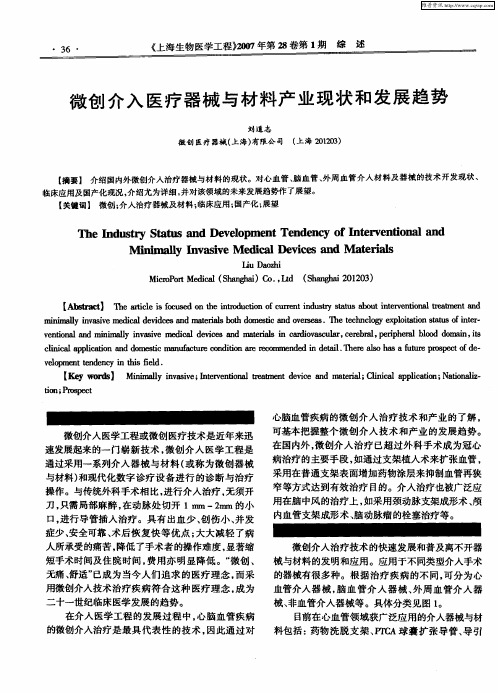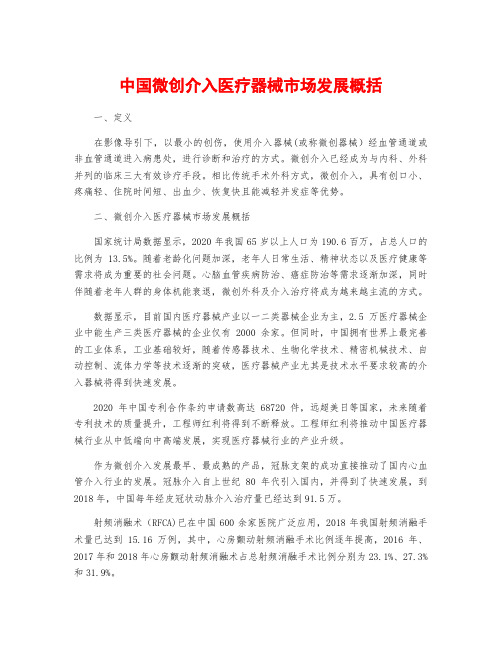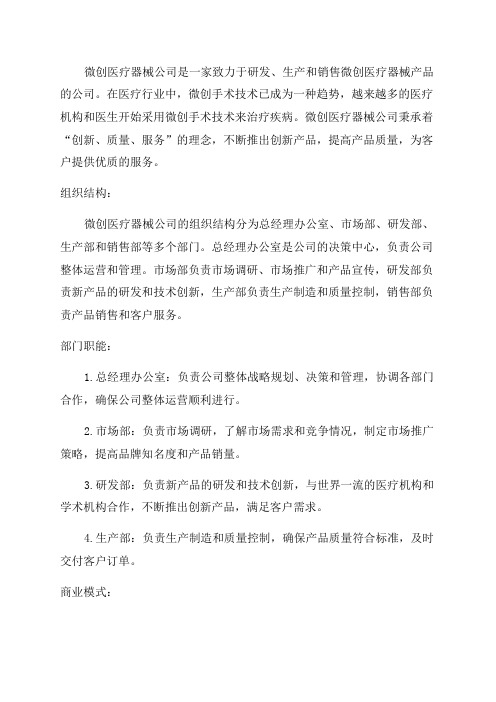微创介入医疗器械与材料产业发展情况
微创介入医疗器械与材料产业的现状和发展趋势

微创介入医疗器械与材料产业的现状和发展趋势随着科技的不断发展和医疗水平的提高,微创介入医疗技术在近年来得到了广泛的应用和推广。
微创介入医疗器械与材料产业作为支撑和核心技术的关键组成部分,也发展迅速并取得了显著的成果。
本文将从现状和发展趋势两个方面来探讨微创介入医疗器械与材料产业的情况。
首先,从现状方面来看,微创介入医疗器械与材料产业目前已经形成了完整的产业链。
该产业链包括微创介入手术器械制造商、材料供应商、研究机构和学术团体等多个环节,构建起了一个相对完善的体系。
在产品方面,介入医疗器械包括导管、支架、植入物等多种设备,材料方面则包括金属、聚合物等多种类型。
这些器械和材料的不断创新和推陈出新,为微创介入医疗提供了强有力的支持。
其次,从发展趋势方面来看,微创介入医疗器械与材料产业将面临一系列新的挑战和机遇。
一方面,随着人口老龄化程度的加深以及慢性疾病的增多,微创介入医疗技术的需求将进一步增强。
这将促使器械制造商加大研发力度,推出更加先进和适用的产品。
另一方面,全球范围内对医疗安全和质量的要求也在不断提高,这将进一步推动微创介入医疗器械与材料产业的规范化和标准化。
因此,未来该产业将面临着更高的技术门槛和更严格的市场准入要求。
在技术方面,随着生物技术和纳米技术的不断发展,微创介入医疗器械与材料产业也将受到更多新技术的影响。
比如,纳米材料的应用将为微创介入医疗器械带来更小、更轻和更灵活的特点,从而提高手术的准确性和可操作性。
同时,基因诊断和个体化医疗的兴起,也将为微创介入医疗器械与材料产业带来更多的市场机遇。
此外,随着人工智能和大数据技术的广泛应用,微创介入医疗器械与材料产业也将面临数字化和智能化的发展趋势。
通过对大量的临床数据实时分析和挖掘,可以更好地指导和优化微创介入手术操作,提高手术效果和患者的治疗效果。
因此,数字化和智能化将成为未来微创介入医疗器械与材料产业发展的重要方向。
总之,微创介入医疗器械与材料产业作为一门新兴的技术产业,目前已经取得了显著的成就,并且面临着广阔的发展前景。
微创介入医疗器械国产化机会与挑战

五、结论
中国医疗器械市场正面临着前所未有的挑战和机会。尽管技术创新能力和行 业标准不一等问题仍然存在,但国内市场的持续增长和“一带一路”倡议的推进 为国内医疗器械企业提供了巨大的发展机遇。新兴技术的应用也将推动中国医疗 器械行业的创新
发展。面对挑战和机会,中国医疗器械企业需要加大研发投入,提升技术创 新能力,加强质量管控,确保产品的安全性和有效性,并积极拓展国内外市场, 以实现持续、健康的发展。
2、行业标准不一:医疗器械行业标准的差异使得不同企业的产品在质量和 安全性上存在差异,这对市场的公平竞争环境构成了威胁。
3、法规遵从成本高:医疗器械法规的严格要求使得企业在研发、生产和销 售等环节的遵从成本增加,这可能对企业的盈利能力和竞争力产生负面影响。
四、中国医疗器械市场的机会
1、国内市场需求持续增长:随着中国经济的发展和人民生活水平的提高, 国内消费者对医疗器械的需求持续增长。这为国内医疗器械企业提供了广阔的市 场空间。
多的技术创新和精准医疗实践在这个领域中得到应用,以满足全球日益增长 的医疗健康需求。
参考内容二
一、引言
中国医疗器械市场在过去的几年中一直保持着稳步的增长,但随着技术的快 速进步和医疗需求的不断演变,这个市场正面临着前所未有的挑战和机会。本次 演示将对中国医疗器械市场的现状进行深入分析,并探讨当前市场所面临的主要 挑战和机遇。
为了抓住机会、应对挑战,国内企业需要采取一系列措施。首先,加强自主 研发能力,提高技术水平。企业应加大研发投入,引进优秀人才,加强与高校、 科研机构的合作,共同推进技术创新。其次,扩大规模、提升产业集中度。通过 兼并重组等方式
,推动企业做大做强,提高产业整体竞争力。此外,加强品牌建设、提升品 牌影响力。企业应注重产品质量和服务,加强与医疗机构的合作与交流,提高国 产产品的知名度和美誉度。
微创介入医疗器械与材料产业现状和发展趋势

.
3 6 .
《 上 海 生 物 医 学 工 程 》 2 0 o 7 年 第2 8
塑 堡!
微 创 介 入 医 疗 器 械 与 材 料 产 业 现 状 和 发 展 趋 势
刘道 志
微 创 医疗器械( 上海) 有限公 司 ( 上海 2 o 1 2 0 3 )
微创介入治疗技术的快速发展和普及离不开器 械与材料的发明和应用 。应用于不同类型介入手术 的器械有很多种 。根据治疗疾病 的不 同, 可分为心 血管介入器 械 , 脑血 管介 入器械 、 外周血 管介入器 械、 非血管介入器械等 。具体分类见图 l 。 目前在心血管领域获广泛应用的介人器械与材 料包括: 药物 洗脱支 架、 P 球囊扩张导管、 导 引
t i o n; Pr o s p e c t
微创介人医学工程或微创 医疗技术是近年来迅 速发展起来的一 门崭新技术 , 微创介人 医学工程是 通过采用一系列介入器械与材料( 或称 为微创器械 与材料 ) 和现 代化 数 字诊 疗 设 备 进 行 的诊 断与 治 疗 操作。与传统外科手术相 比, 进行介入治疗 , 无须开 刀, 只需局部麻醉 , 在动脉处切开 l衄 一 2 r m n的小 口, 进行导管插入治疗。具有 出血少 、 创伤小、 并发 症少 、 安全可靠、 术后恢 复快 等优点 ; 大大减轻了病 人所承受的痛苦 , 降低 了手术者的操作难度 , 显著缩 短手术时间及住院时间, 费用亦明显降低 。“ 微创 、 无痛 、 舒适” 已成 为当今人们追求 的医疗理念 , 而采 用微创介入技术治疗疾创 介入治疗器械 与材料 的现状 。对 心血管 、 脑 血管 、 外周 血管 介入材 料及 器械 的技术 开发现状 、 临床应用及国产化现况 , 介绍 尤为详细 , 并对该领域的未来发展趋势作 了展望 。
医疗器械的微创介入与介入手术技术

医疗器械的微创介入与介入手术技术在医学领域中,随着技术的不断进步和创新,微创介入与介入手术技术已经成为一种受到广泛应用的治疗手段。
这种技术可以帮助患者获得更快、更有效的治疗,同时减少了手术创伤和恢复期的痛苦。
本文将介绍医疗器械的微创介入与介入手术技术的发展、应用和前景。
一、微创介入技术的发展随着医学图像学和医疗器械技术的不断进步,微创介入技术得以快速发展。
微创介入技术利用放射学、超声学和内窥镜等技术来引导医疗器械进入体内,通过微小的切口或自然孔道,进行诊断和治疗。
它不仅可以取代传统的手术方式,同时还能够提供更准确的诊断和更精细的治疗。
二、微创介入技术的应用微创介入技术在多个医疗领域中都有广泛的应用。
例如,在肿瘤学中,微创介入技术可以用于肿瘤的诊断和治疗。
通过经皮穿刺或经血管穿刺的方式,医生可以使用放射学或超声学引导下的治疗器械,精确地注射抗肿瘤药物或进行肿瘤的消融治疗。
此外,微创介入技术还被应用于心血管疾病的治疗、神经外科手术、妇科疾病的治疗等多个领域。
三、介入手术技术的发展介入手术技术是微创介入技术的一个重要分支,它是指通过血管或自然孔道进入人体内部进行手术治疗的技术。
随着医疗器械技术的日益成熟,介入手术技术在越来越多的领域中得到了广泛应用。
常见的介入手术包括血管介入手术、尿道介入手术、胃肠道介入手术等。
四、介入手术技术的优势与传统手术方式相比,介入手术具有许多优势。
首先,介入手术只需要微小的切口或自然孔道,不需要进行大规模的切割和切开,因此可以减少患者的疼痛和创伤。
其次,介入手术对患者的恢复期要求低,可以缩短住院时间,减少医疗费用。
此外,由于介入手术操作精细,医生可以更准确地进行诊断和治疗,提高治疗效果。
五、微创介入与介入手术技术的前景微创介入与介入手术技术在医学领域中有着广阔的应用前景。
随着医学器械技术和图像学技术的不断发展,人们对微创手术和介入手术技术的需求将越来越高。
另外,随着人口老龄化进程的加快,慢性病的发病率不断增加,微创介入与介入手术技术可以提供更好的治疗方式和效果,在满足患者需求的同时,也为医生提供了更有效的工具。
心血管介入医疗器械行业发展趋势

政府对医疗器械行业的政策支持力 度加大,如鼓励创新、简化审批流 程等,为行业发展带来机遇。
未来发展趋势预测
个性化医疗器械的需求增长
随着医疗技术的进步和患者需求的提高,个性化医疗器械的需求 将不断增加,如定制化的心脏支架、人工血管等。
技术融合发展
未来心血管介入医疗器械将与其它领域的技术融合发展,如机器人 技术、智能材料等,形成更加智能、高效的治疗方案。
心血管介入医疗器械行业发 展趋势
汇报人:
2023-11-21
• 行业概述 • 行业市场现状 • 行业发展趋势 • 行业竞争格局 • 行业风险与机遇 • 结论和建议
01
行业概述
心血管介入医疗器械定义
01
心血管介入医疗器械是指用于心 血管疾病诊断和治疗过程中所需 的医疗器械,包括心脏支架、起 搏器、导管、球囊、压力泵等。
微创医疗
作为心血管介入领域的领先企业,微创医疗在国内市场占有重要地位。 其产品线覆盖广泛,包括冠心病、结构性心脏病、瓣膜病等领域的介入 治疗产品。
乐普医疗
乐普医疗在心血管介入领域也有较强的竞争力,其产品包括药物洗脱支 架、金属支架等。
03
赛诺医疗
赛诺医疗是国内较早进入心血管介入领域的公司之一,其产品包括药物
心血管介入医疗器械行业受到政策支 持的影响较大,企业应密切关注政策 动向并积极申请相关资质。
对行业的建议
推动行业技术创新,加大对新 产品和新技术的研发投入,提
高国产化率。
加强与国际先进企业的合作, 引进先进技术和管理经验,提
高行业整体水平。
建立健全行业标准和质量管理 体系,保障产品质量和安全。
发挥行业协会作用,加强与政 府部门的沟通协调,推动政策 落地和行业发展。
2024年介入手术室市场发展现状

2024年介入手术室市场发展现状概述介入手术室是现代医疗领域的重要组成部分,旨在通过微创手术技术,减少手术创伤、缩短手术时间、提高手术效果,从而更好地满足患者的手术需求。
随着医疗技术的不断进步和人们对健康意识的提高,介入手术室市场得到了持续的发展和壮大。
市场规模目前,全球介入手术室市场规模正在逐年增长。
根据市场调研机构的数据显示,2019年全球介入手术室市场规模达到100亿美元,并预计到2025年将达到150亿美元。
这一增长趋势主要得益于手术技术的不断创新和手术需求的增加,尤其是心血管疾病、癌症等慢性病的患者人数不断增加。
发展趋势随着科技的不断进步,介入手术室市场呈现出以下几个发展趋势:1. 技术创新介入手术室市场的发展受益于医疗技术的不断创新。
新的手术器械、设备和技术的引入,使得介入手术更加精确、安全和高效。
例如,机器人辅助手术、三维可视化手术系统等技术的应用,显著改善了手术操作的准确性和可视化程度,提高了手术的成功率和患者的生活质量。
2. 多学科合作介入手术室的发展趋势是多学科合作的加强。
不同领域的专家共同参与手术决策和手术操作,提高了手术治疗的综合效果。
多学科合作还促进了经验和知识的交流,推动了介入手术室的技术进步和创新。
3. 医疗设备智能化随着人工智能技术的发展,介入手术室的医疗设备趋向智能化。
通过数据采集、分析和反馈,可以帮助医生更准确地判断病情、制定手术方案,并优化手术操作过程。
这不仅提高了手术效果,还减少了手术风险和并发症的发生。
4. 客户需求个性化患者对手术治疗的需求不断个性化和差异化,这对介入手术室市场提出了新的挑战和机遇。
为了满足不同患者的需求,介入手术室逐渐向定制化发展,推出了更多个性化的手术方案和售后服务。
市场竞争态势当前,全球介入手术室市场竞争激烈,主要厂商包括美敦力、英戈尔等国际知名品牌。
在不断增长的市场需求下,厂商们不断加大研发投入,提升产品质量,推出更多创新产品。
介入医疗器械的发展现状与趋势

介入医疗器械的发展现状与趋势医疗器械在医疗健康领域具有至关重要的地位,其中介入医疗器械作为一类重要的医疗器械,广泛应用于疾病的治疗和诊断。
本文将围绕介入医疗器械的发展现状与趋势进行深入探讨。
介入医疗器械是指通过血管、皮肤或自然腔道进入人体内部,辅助医生进行治疗、诊断和预防的医疗设备。
随着医疗技术的不断进步,介入医疗器械市场发展迅速,成为医疗行业的重要支柱。
目前,介入医疗器械市场呈现出强劲的增长趋势。
据统计,全球介入医疗器械市场规模预计在未来几年内将以每年5%的速度增长,到2025年将达到500亿美元。
在这个市场中,涌现出了一批优秀的国内企业和国际企业,竞争日益激烈。
在技术方面,介入医疗器械不断创新和发展。
智能化、数字化、微型化、个性化等成为介入医疗器械的重要发展趋势。
例如,人工智能技术在介入医疗器械中的应用越来越广泛,数字化影像技术使得医生可以更准确地诊断和治疗疾病。
同时,随着人们健康意识的提高和医疗需求的增加,介入医疗器械的客户需求也发生了变化。
客户不再仅仅设备的性能和价格,而是更加重视产品的舒适性、安全性和有效性。
客户对产品的个性化需求也逐渐增加,企业需要针对不同客户需求提供定制化的产品和服务。
未来,介入医疗器械的发展将呈现出以下趋势:市场将继续保持增长,国内外企业竞争将更加激烈。
国内企业需要加强技术研发和创新,提高产品质量和竞争力;技术创新将成为竞争的核心,企业需要新技术的发展趋势,加快技术转化和应用;客户需求将得到进一步满足,企业需要加强与客户的沟通,深入了解客户需求,提供更加优质的产品和服务;行业监管将进一步加强,企业需要合规经营,注重产品质量和安全性,以满足国家和国际标准。
介入医疗器械的发展前景广阔,市场规模将持续增长,技术创新和客户需求将成为推动行业发展的关键因素。
企业需要加强自身技术研发和创新能力,深入了解客户需求,提高产品质量和安全性,以适应市场的不断变化和行业发展的趋势。
随着医疗技术的不断进步,微创介入疗法在临床上的应用越来越广泛,带动了微创介入医疗器械与材料产业的快速发展。
中国微创介入医疗器械市场发展概括

中国微创介入医疗器械市场发展概括一、定义在影像导引下,以最小的创伤,使用介入器械(或称微创器械)经血管通道或非血管通道进入病患处,进行诊断和治疗的方式。
微创介入已经成为与内科、外科并列的临床三大有效诊疗手段。
相比传统手术外科方式,微创介入,具有创口小、疼痛轻、住院时间短、出血少、恢复快且能减轻并发症等优势。
二、微创介入医疗器械市场发展概括国家统计局数据显示,2020年我国65岁以上人口为190.6百万,占总人口的比例为13.5%。
随着老龄化问题加深,老年人日常生活、精神状态以及医疗健康等需求将成为重要的社会问题。
心脑血管疾病防治、癌症防治等需求逐渐加深,同时伴随着老年人群的身体机能衰退,微创外科及介入治疗将成为越来越主流的方式。
数据显示,目前国内医疗器械产业以一二类器械企业为主,2.5万医疗器械企业中能生产三类医疗器械的企业仅有2000余家。
但同时,中国拥有世界上最完善的工业体系,工业基础较好,随着传感器技术、生物化学技术、精密机械技术、自动控制、流体力学等技术逐渐的突破,医疗器械产业尤其是技术水平要求较高的介入器械将得到快速发展。
2020年中国专利合作条约申请数高达68720件,远超美日等国家,未来随着专利技术的质量提升,工程师红利将得到不断释放。
工程师红利将推动中国医疗器械行业从中低端向中高端发展,实现医疗器械行业的产业升级。
作为微创介入发展最早、最成熟的产品,冠脉支架的成功直接推动了国内心血管介入行业的发展。
冠脉介入自上世纪80年代引入国内,并得到了快速发展,到2018年,中国每年经皮冠状动脉介入治疗量已经达到91.5万。
射频消融术(RFCA)已在中国600余家医院广泛应用,2018年我国射频消融手术量已达到15.16万例,其中,心房颤动射频消融手术比例逐年提高,2016年、2017年和2018年心房颤动射频消融术占总射频消融手术比例分别为23.1%、27.3%和31.9%。
2013-2018年,中国起搏器植入量从 5.65万增长至8.28万,年复合增速达7.94%。
介入医疗器械的发展现状与趋势

l in i c a l ly d e
w
v e
lo p m
t is f o c u s e
o
d
o n
R& D la
r
0
f
a
b la t io
tio n a
n
th e te
v
d
r e
la te d
o u e
— — — — —
q u ip m
to
tr ia l
n
i f b r il la t i o
a n
。
治 疗 冠 状 动 脉狭 窄 的安 全 性 和 有效 性 获 得 医 学 界认 可
,
在 电 生 理 介入 导 管 方 面
以 射 频 消融 导 管 治 疗各 类 心 动 过 速 的 技 术 也 正
,
本 文 综 述 了 以 心 脑 血 管 介 人 器 械 为 主 的器 械 技 术 发 展 现 状
对 主 要 器 械 的技 术 发 展 趋 势 进
l th e g
py ha
be
p id ly
e a s e
r
e x
pa
n
de d to t r
n
t in g n e u r o
r
v a s c u
la
di
s e a s e e a
c a r o t id s te n t a n
d dis ta l
b o lic de
ic
e
v e
bee
e n
u s e
de
s
— — —
lo p in g d ir e c t io C a r d io
2024年微创医疗器械公司组织结构部门职能商业模式行业现状

微创医疗器械公司是一家致力于研发、生产和销售微创医疗器械产品的公司。
在医疗行业中,微创手术技术已成为一种趋势,越来越多的医疗机构和医生开始采用微创手术技术来治疗疾病。
微创医疗器械公司秉承着“创新、质量、服务”的理念,不断推出创新产品,提高产品质量,为客户提供优质的服务。
组织结构:微创医疗器械公司的组织结构分为总经理办公室、市场部、研发部、生产部和销售部等多个部门。
总经理办公室是公司的决策中心,负责公司整体运营和管理。
市场部负责市场调研、市场推广和产品宣传,研发部负责新产品的研发和技术创新,生产部负责生产制造和质量控制,销售部负责产品销售和客户服务。
部门职能:1.总经理办公室:负责公司整体战略规划、决策和管理,协调各部门合作,确保公司整体运营顺利进行。
2.市场部:负责市场调研,了解市场需求和竞争情况,制定市场推广策略,提高品牌知名度和产品销量。
3.研发部:负责新产品的研发和技术创新,与世界一流的医疗机构和学术机构合作,不断推出创新产品,满足客户需求。
4.生产部:负责生产制造和质量控制,确保产品质量符合标准,及时交付客户订单。
商业模式:微创医疗器械公司的商业模式主要是以产品销售为主要盈利方式,同时开展技术合作和技术转让,积极开拓国内外市场,不断扩大企业规模和影响力。
公司通过不断创新和提高产品质量,赢得客户信赖,建立良好的品牌形象,实现良性发展。
行业现状:随着人口老龄化和医疗技术的进步,微创手术技术在医疗行业中的应用越来越广泛。
微创医疗器械市场规模不断扩大,技术水平不断提高,产品种类不断丰富,市场竞争也日益激烈。
在这个竞争激烈的市场中,微创医疗器械公司需要不断提高自身核心竞争力,加强技术研发,创新产业模式,拓展市场渠道,抢占市场先机,实现可持续发展。
综上所述,微创医疗器械公司在未来的发展过程中,应加强技术研发、提高产品质量、拓展市场渠道、提升品牌形象,不断推动公司向更高层次发展,实现可持续发展。
生物医用材料的发展与介入医疗器械的产业化

越来越高, 因而对 于生物医用材料 的研 究也 不断 深入 。 以新 材料 的应用 为突
有 8万例PCI 0 手术 , 而中国 1 年仅 3 0 00
破 口, 介入医疗 器械本身的性能发生飞
发 展密不 可分 。
能 的新 型高 技术 材 料, 研 究 人工 器 是 官 和 医疗器 械 的基 础 。 种合 成材 料 各 和天 然高分 子材料 、 金属 和合 金材料、
陶瓷 和碳 素材料 以及各种复合材料 制
新 要 求, 医用材 料 性 能得 到 了飞 速 发 展, 两者相 辅相成 , 医疗器 械产业链 是 中极 其 重 要 的两个 节点 , 同推 动着 共 医疗 技术 的发展 。
动新材料的应用
随着新的医疗器械 和医疗技术 的
应用, 人们对于 医疗 产品的性能要求也
科 等学 科。 中国, 在 微创 介入技 术起 步 比较 晚— — 19 年 微创 公司成 立 时, 98 距离全世界第一例P I 冠状 动脉介入 C(
术) 已过去 2 年, 0 当时 的美 国每年大约
金等。
三 对 中国介 入 医疗器 械产 业 链发展 的思考
介入医疗 技术是 2 世 纪末医学对 0 人类文明的重要贡献 , 由于微创介 人 手 术 的出现 , 18 - 0 1 , 从 9 0 2 0年 心血 管疾
病 死亡率 下降了4 %, 0 微创介入医疗 作
为一种 手术方法 , 几乎已经涵 盖 血 脑血管、 癌症、 外科、 妇科、 耳鼻 咽喉 二、 介入 医疗器 械产 业发 展 推 管、
成品 , 已经被广 泛应 用于人工器官、 外
ห้องสมุดไป่ตู้
靳鲥料产业 N . 2 1 目 O 7 0 0● 日
2024年微创医疗手术器械市场发展现状

微创医疗手术器械市场发展现状1. 引言随着医疗技术的不断进步和人们对手术风险的不断关注,微创医疗手术器械市场正迅速发展。
微创手术采用了更小、更精确的手术工具,可以减少手术创伤、减轻患者痛苦并缩短恢复时间。
本文将探讨微创医疗手术器械市场的发展现状,并分析其前景和挑战。
2. 微创手术器械的定义和分类微创手术器械是指通过微小切口或自然腔道进入体内进行手术的器械。
根据其使用的技术和应用领域,可以将微创手术器械分为内窥镜手术器械、介入手术器械和机器人辅助手术器械等。
3. 微创医疗手术器械市场的发展现状3.1 市场规模和增长趋势据市场研究报告显示,微创医疗手术器械市场在过去几年里保持了快速的增长势头。
随着人们对健康的关注和医疗技术的不断创新,预计市场规模将在未来几年继续扩大。
3.2 技术创新和产品发展微创手术器械市场的发展得益于技术创新和产品发展。
近年来,许多制造商不断推出新型的微创手术器械,以满足医生和患者对更高效、更安全手术的需求。
这些创新产品的不断涌现,推动了市场的进一步发展。
3.3 医疗机构的需求和应用扩展医疗机构对微创手术器械的需求也在不断增加。
随着微创手术技术的普及和医生对其熟练程度的提高,越来越多的医疗机构开始采用微创手术器械进行各类手术。
这种需求的扩展进一步推动了市场的增长。
3.4 医疗保健政策的支持政府对医疗保健行业的支持也起到了推动微创医疗手术器械市场发展的重要作用。
政策的支持包括财政补贴、技术培训和研究资助等,为微创手术器械市场的发展提供了有力的支持。
4. 微创医疗手术器械市场的前景和挑战4.1 前景微创医疗手术器械市场的前景十分广阔。
随着医疗技术的进一步创新和产品的不断改进,微创手术将越来越多地应用于各个医疗领域。
微创手术的优势和潜力将推动市场的持续发展。
4.2 挑战微创医疗手术器械市场也面临一些挑战。
首先,微创手术器械的高端技术和昂贵成本限制了市场的规模和普及程度。
其次,对于医生和医疗机构来说,使用微创手术器械需要较长的培训和适应期,这也限制了其应用范围和速度。
2023年微创外科手术器械行业市场发展现状

2023年微创外科手术器械行业市场发展现状
随着医疗技术的不断进步和人民对医疗健康的日益重视,微创外科手术器械行业开始受到广泛关注。
此行业的市场发展现状包括以下几个方面:
一、市场规模不断扩大
随着人们对健康投入的意识不断提高,微创外科手术器械行业的市场需求量逐年增加。
据统计,2019年我国微创外科手术器械市场规模约为264亿元。
而据预测,到
2024年,我国微创外科手术器械市场规模预计将达到400亿元以上。
二、行业竞争日益激烈
随着市场规模的不断扩大,微创外科手术器械行业的竞争也日益激烈。
目前,国内外多家医疗器械生产企业纷纷进入该领域,形成了激烈的竞争态势。
在这种情况下,一些企业通过技术创新和产品质量提升,不断增强市场竞争力,反之,则被淘汰出市场。
三、国内外市场结构不同
由于各国对医疗器械认定标准、消费习惯等的差异,导致国内外市场的结构存在差异。
在国内市场,仍存在大量低端产品的竞争,高端产品市场尚处于培育阶段。
而在国际市场,高端产品市场日趋成熟,国产品牌进入该领域的难度比较大。
四、技术创新成为市场主导
随着技术创新的不断推进,微创外科手术器械的技术含量不断提高,产品也在不断升级。
例如,激光技术和机器人技术等的应用,使手术过程更精准、更安全、更高效。
这些新技术的应用也使企业可以更好地满足市场需求,提高了企业的市场竞争力。
总的来说,微创外科手术器械行业市场发展前景广阔,国内企业应不断加强技术研发,提升产品质量,加强品牌建设,争取更大市场份额。
同时,应该加强与国际市场的交流,拓展海外市场,推动国产微创外科手术器械走向海外。
2024年介入医疗器械市场规模分析

2024年介入医疗器械市场规模分析简介本文旨在对介入医疗器械市场的规模进行详细分析。
介入医疗器械指的是应用于手术和治疗中,通过通过人体的血管、导管、气道或腔道进行内窥镜检查、介入、手术或治疗的设备。
随着医学技术的不断进步,介入医疗器械市场迅速发展,并呈现出较大的潜力。
市场规模分析1.全球介入医疗器械市场规模介入医疗器械市场在全球范围内呈现稳步增长的趋势。
根据市场研究机构的数据,预计到2025年,全球介入医疗器械市场规模将达到XXX亿美元。
2.市场地区分析介入医疗器械市场在不同地区的规模存在一定差异。
目前,北美地区是全球介入医疗器械市场的主要驱动力,占据了相当大的市场份额。
欧洲和亚太地区也是潜力巨大的市场,其中亚太地区的增长速度最快。
3.市场产品分析介入医疗器械市场的产品种类繁多,主要涵盖了导管、缝线、球囊、导丝、支架等。
其中,导管是市场上最常用的介入医疗器械产品之一,用于对血管、气道或腔道进行检查和治疗。
4.市场应用领域分析介入医疗器械的应用领域广泛,包括血管介入、心脏介入、神经介入、消化道介入等。
其中,血管介入市场规模最大,占据了整个介入医疗器械市场的较大份额。
5.市场发展趋势分析随着人们健康意识的提高和医疗技术的不断发展,介入医疗器械市场将继续保持较快的增长。
同时,随着老龄化人口的增加和慢病的普遍存在,介入医疗器械在疾病治疗和康复中的应用将得到更广泛的认可。
结论介入医疗器械市场具有较大的发展潜力和市场空间。
随着科技进步和医学研究的不断深入,该市场将继续迎来新的机遇。
同时,市场竞争也将不断加剧,企业需积极创新和提高产品技术水平,以适应市场变化。
对于投资者来说,介入医疗器械市场是一个具有较高投资价值的行业,值得关注和重视。
以上就是对介入医疗器械市场规模的详细分析。
希望本文能够为读者提供有价值的信息,并对相关行业的从业者和投资者有所帮助。
注意:本文所述为笔者根据市场研究数据进行的分析,仅供参考,不构成任何投资建议。
2024年微创介入医疗器械市场前景分析

2024年微创介入医疗器械市场前景分析摘要本文旨在通过对微创介入医疗器械市场的前景进行分析,帮助读者了解该市场的潜力和发展趋势。
首先,文章介绍了微创介入医疗器械的定义和分类。
然后,结合市场数据和趋势,分析了微创介入医疗器械市场的发展前景。
最后,本文总结了微创介入医疗器械市场的投资机会和挑战,并提出了未来的发展建议。
1. 介绍微创介入医疗器械是指使用微小的切口或体内导管技术进行诊断和治疗的一类医疗器械。
它们可以通过体内导管获得对病灶的直接观察和干预,避免了传统外科手术的大面积切割,具有创伤小、恢复快、住院时间短等优点。
目前,微创介入医疗器械已广泛应用于心血管疾病、神经病学疾病、泌尿系统疾病等多个领域。
2. 市场规模和趋势分析根据市场数据和趋势分析,微创介入医疗器械市场呈现出以下几个重要趋势:•市场规模持续增长:随着人们对健康的重视和医疗技术的进步,微创介入医疗器械市场规模呈现出持续增长的趋势。
预计未来几年内,市场规模将进一步扩大。
•技术创新推动市场发展:微创介入医疗器械市场受益于不断推出的新技术和新产品,如立体定向导航系统、无线输液泵等。
这些技术创新大大提高了手术精确性和患者的治疗效果,推动了市场的快速发展。
•人口老龄化推动市场需求:随着人口老龄化问题日益突出,慢性疾病的发病率逐渐增加,对微创介入医疗器械的需求也在不断增加。
这一趋势将为市场提供持续增长的动力。
3. 投资机会和挑战微创介入医疗器械市场存在着丰富的投资机会,但也伴随着一些挑战:•投资机会:随着市场的扩大和技术的进步,微创介入医疗器械市场将出现更多的投资机会。
这些机会包括新产品开发、技术合作和进入新兴市场等。
•市场竞争激烈:随着市场的发展,微创介入医疗器械市场的竞争将越来越激烈。
企业需要不断提升产品品质和技术水平,以保持竞争优势。
•法规监管:微创介入医疗器械涉及到患者的生命健康,因此在市场准入和产品注册方面存在着严格的法规监管。
企业需要符合法规要求,以免遭受法律风险。
- 1、下载文档前请自行甄别文档内容的完整性,平台不提供额外的编辑、内容补充、找答案等附加服务。
- 2、"仅部分预览"的文档,不可在线预览部分如存在完整性等问题,可反馈申请退款(可完整预览的文档不适用该条件!)。
- 3、如文档侵犯您的权益,请联系客服反馈,我们会尽快为您处理(人工客服工作时间:9:00-18:30)。
介入医学工程发展专题报告Report on the development of interventionalmedicine1 National Institute for the Control of Pharmaceutical and Biological Products, Beijing 100050, China2 MicroPort Medical(Shanghai) Co., Ltd., Shanghai 201203, China3 Department of Advanced Materials and Nanotechnology, College of Engineering, Peking University, Beijing 100871, ChinaAbstractInterventional therapy has the advantages of minimal invasiveness, duplication, accurate position, high and more rapid effect, less combination, and easy to applied along with many other techniques. Interventional radiology becomes the third therapeutic discipline keeping pace with internal medicine and surgery, and consists of abdominal interventional radiology, interventional cardio-radiology, interventional neuro-radiology and interventional gynaeco-radiology sub-branches. This chapter, consisting of three parts, reviewed the current domestic and overseas status about both interventional therapy and minimally invasive medical devices and materials, with special attention on the technology research and development, clinical application, and domestic manufacture condition of the medical devices and materials used within cardiovascular, cerebrovascular and peripheral blood vessels. Future prospect of development tendency on the interventional medical engineering is proposed after objective analysis and comprehensive evaluation.In part I, the current research situation of interventional medicine has been reviewed. A broad range of technologies had played a role in image-guided interventions, including magnetic resonance imaging, ultrasound, X-ray and computed tomography, and optical imaging technologies. They assisted the physician to see and diagnose diseases such as cardiovascular disease, peripheral arterial disease, tumors, urinary tract disease, abdominal cavity disease, gynaecology and obstetrics disease, vertebroplasty, etc. The common interventional therapy techniques included the angioplasty & stent placement, occlusion, perfusion, Needle biopsy and ablation. The current research situation of interventional therapy materials and devices has been summarized. Various metal materials and polymers are the main raw materials for manufacturing the current interventional therapy devices. The polymers included the PTFE, Pebax, Nylon, PI, ePTFE, PVA, PLLA, whereas the metal materials included the 316L stainless steel, Nitinol, Elgiloy, MP35N, L605, Ta, Mg alloy, ets. They were used to fabricate diagnostic catheters, guidewires, balloon catheters, Stents, thombectomy devices, embolic protection devices, atherectomy catheters, aortic stent grafts, IVC filters, etc, by the form of bulk materials and thin films, and sometime even composited with the drugs.In Part II, the comparison between domestic and overseas status on the interventional medical engineering subject had been given. It can be easily found that the chinese interventional therapy materials and devices industry is just at the initial stage, with the following features, small investment scale and limited facilities, lack of self-owned intellectual property, difficult to find related domestic raw material manufacturer and OEM services, shortage of qualified technical expert and manager human resource, and scarce of authorized characterization and evaluation unit or organization of the quality of interventional therapy device and materials, etc.In Part III, future prospect on the research direction and strategy of interventional medical engineering subject had been proposed. Advanced interventional therapy techniques and revolutionary diagnostic equipments, and novel functional materials would be developed with effort of interventional radiologists, engineering technology researchers and materials scientist. As technology advances, and ever improving, high-quality imaging equipment becomes more widely available, Interventional radiology will be able to offer those suffering from a wide range of ailments – from osteoporosis and infertility to cancer and heart disease – a better quality of life now, and renewed hope for the future.一、介入医学工程的发展现状(一)介入医学工程概述介入医学( Interventional Medicine) 是近20~30 年以来的一门临床诊断和治疗学科。
它介于外科手术和内科药物疗法之间,采用导管或腔镜技术进行各种低创伤性诊治。
从技术角度,介入医学可分类为:①经皮血管腔内造影或成形术,即穿刺血管后,将导管置入选择的血管处,推注造影剂可连续、动态使血管腔显影,称为选择性血管造影。
若造影发现某部位(如冠状动脉、肾动脉等)血管局限性狭窄,可用球囊充盈扩张狭窄处,使其通畅。
扩张后也可以放置支架,以防止血管再狭窄。
②经皮心腔瓣膜成形术,如二尖瓣等狭窄,也可用球囊扩张。
③经皮心血管缺损封堵术,通过心导管将封堵片放在缺损口部位堵塞分流(如心房间隔缺损或动脉导管未闭等) 。
